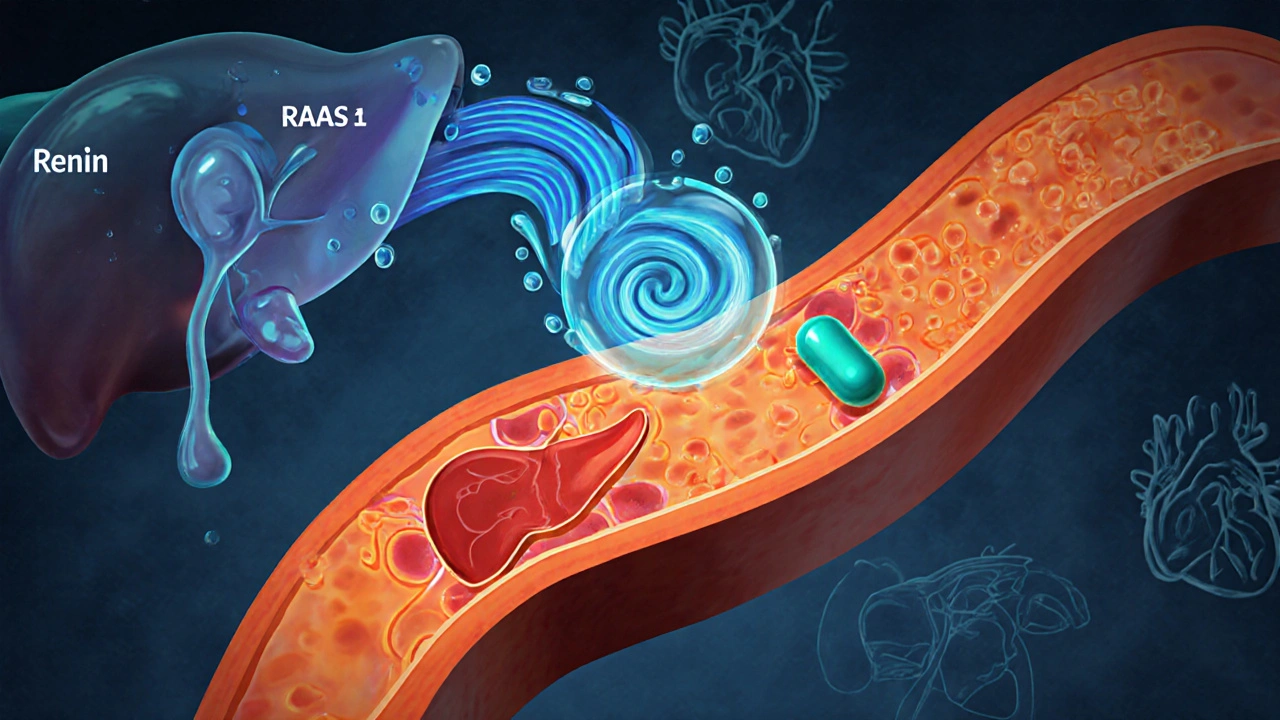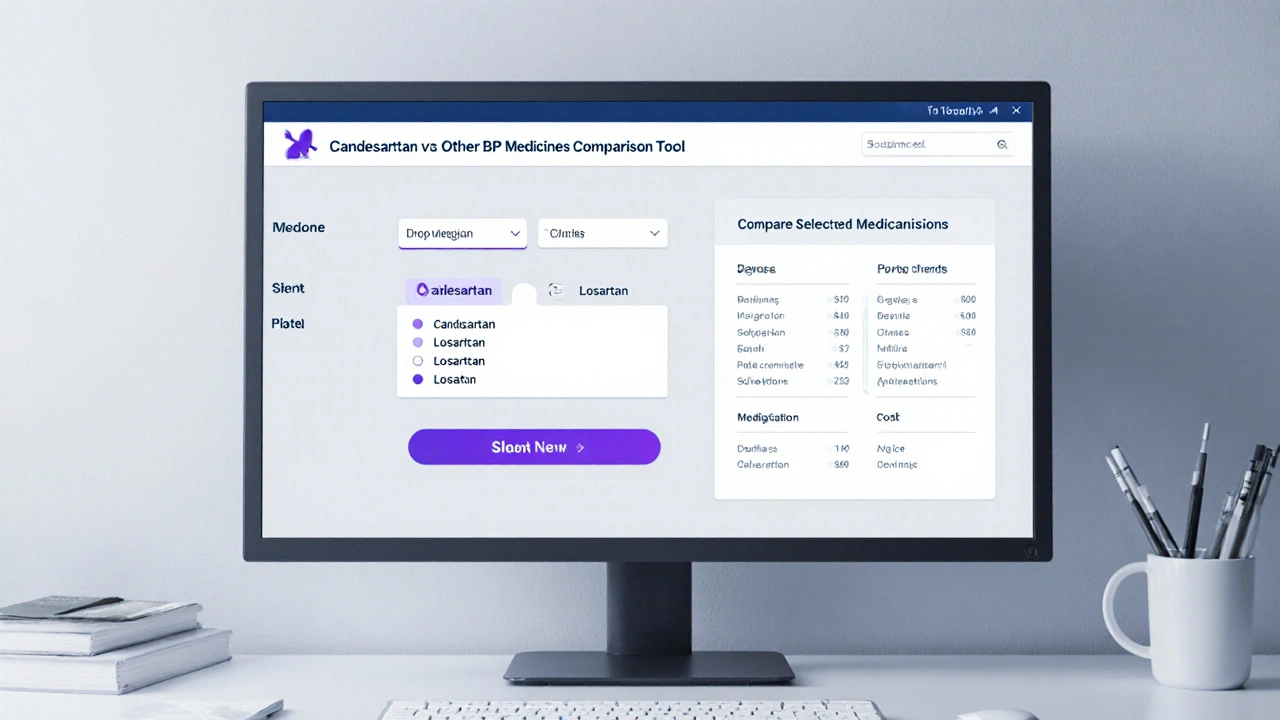Candesartan vs Other BP Medicines Comparison Tool
Select Medications to Compare
Medication Details
If you're weighing candesartan against other blood‑pressure options, this guide breaks it down.
TL;DR - Quick Takeaways
- Candesartan (Atacand) is an ARB that blocks the effects of angiotensin II, lowering blood pressure.
- Top alternatives include other ARBs (losartan, valsartan), ACE inhibitors (lisinopril, enalapril), calcium‑channel blockers (amlodipine) and beta‑blockers (metoprolol).
- ARBs are generally well‑tolerated; ACE inhibitors can cause cough, while calcium‑channel blockers may cause swelling.
- Cost varies - generic ARBs are cheap, brand‑name Atacand can be pricier in Australia.
- Choose based on kidney function, presence of diabetes, side‑effect profile, and doctor’s guidance.
What Is Candesartan (Atacand)?
Candesartan is a prescription medication classified as an angiotensin II receptor blocker (ARB). It is sold under the brand name Atacand in many countries, including Australia. By blocking the angiotensin II type 1 (AT1) receptor, candesartan prevents the hormone from tightening blood vessels, which helps to lower systemic blood pressure.
Typical adult dosing starts at 8mg once daily, with a usual maintenance range of 16mg to 32mg. The drug is taken orally, with or without food, and works best when paired with lifestyle changes like reduced sodium intake and regular exercise.
How Candesartan Works - The RAAS Connection
The renin‑angiotensin‑aldosterone system (RAAS) regulates blood pressure and fluid balance. When blood volume drops, the kidneys release renin, which converts angiotensinogen to angiotensin I. Angiotensin‑converting enzyme (ACE) then turns angiotensin I into angiotensin II, a potent vasoconstrictor. Angiotensin II also triggers aldosterone release, prompting the kidneys to retain sodium and water.
Renin‑Angiotensin‑Aldosterone System (RAAS) is a hormonal cascade that controls blood pressure and fluid balance. Candesartan interferes at the final step by blocking the AT1 receptor, which means angiotensin II can no longer force the vessels to constrict. The result is relaxed vessels, reduced blood pressure, and decreased workload on the heart.
When Doctors Prescribe Candesartan
Doctors often choose candesartan for patients with:
- Essential hypertension that hasn't responded to first‑line therapy.
- Heart failure with reduced ejection fraction (where ARBs improve survival).
- Diabetic kidney disease - ARBs protect the kidneys by lowering intraglomerular pressure.
- Patients who previously experienced cough with ACE inhibitors.
Because candesartan is metabolized mainly by the liver and excreted unchanged, it is relatively safe in mild‑to‑moderate kidney impairment. However, it should be used cautiously in severe renal failure or in patients taking potassium‑sparing diuretics, as the combination can raise potassium levels.

Popular Alternatives - Who Else Is in the Game?
Below are the most common medication families that doctors consider when candesartan isn’t the best fit.
Other Angiotensin II Receptor Blockers (ARBs)
Losartan is an ARB introduced before candesartan and often used as a first‑line option. It shares the same mechanism but is typically dosed at 50mg-100mg daily. Losartan has a slightly shorter half‑life, which may affect once‑daily dosing in some patients.
Valsartan is another ARB, popular for its once‑daily dosing and favourable safety profile. Standard dose ranges from 80mg to 320mg per day.
Irbesartan is especially useful for patients with type‑2 diabetes and micro‑albuminuria. Typical dosing is 150mg-300mg daily.
ACE Inhibitors - The Cough‑Prone Cousins
Lisinopril is an ACE inhibitor widely prescribed for hypertension and heart failure. Starting dose is 10mg daily, titrating up to 40mg. While effective, up to 10% of patients develop a dry cough due to increased bradykinin.
Enalapril offers a similar efficacy profile but can be started at a lower dose (5mg) and is often chosen for patients with modest kidney disease.
Calcium‑Channel Blockers (CCBs)
Amlodipine is a long‑acting dihydropyridine CCB that relaxes vascular smooth muscle. It is administered once daily at 5mg-10mg. Common side effects include peripheral edema and a mild increase in heart rate.
Beta‑Blockers
Metoprolol is a cardioselective beta‑blocker that reduces heart rate and contractility. Doses range from 50mg to 200mg per day, usually split into two doses. It’s useful for hypertension with concomitant angina or arrhythmias but can worsen asthma symptoms.
Side‑by‑Side Comparison Table
| Drug | Class | Typical Daily Dose | Primary Mechanism | Major Side Effects | Cost (AU$) - Generic |
|---|---|---|---|---|---|
| Candesartan | ARB | 8-32mg | AT1‑receptor blockade | Dizziness, hyper‑kalemia | ~$25-35 per month |
| Losartan | ARB | 50-100mg | AT1‑receptor blockade | Cough, dizziness | ~$15-20 per month |
| Valsartan | ARB | 80-320mg | AT1‑receptor blockade | Headache, hyper‑kalemia | ~$12-18 per month |
| Lisinopril | ACE inhibitor | 10-40mg | ACE inhibition | Cough, angioedema | ~$8-12 per month |
| Amlodipine | Calcium‑channel blocker | 5-10mg | L-type Ca²⁺ channel blockade | Edema, flushing | ~$10-14 per month |
| Metoprolol | Beta‑blocker | 50-200mg | β₁‑receptor antagonism | Fatigue, bronchospasm | ~$9-13 per month |
Who Should Choose Which Drug?
Below is a quick “best‑for / not‑for” snapshot.
- Candesartan: Best for patients with chronic kidney disease or a history of ACE‑inhibitor cough. Not ideal if potassium levels are already high.
- Losartan / Valsartan / Irbesartan: Good alternatives when a physician wants an ARB but prefers a lower cost or specific dosing flexibility. Avoid in severe liver disease (valsartan needs hepatic metabolism).
- Lisinopril / Enalapril: Strong choice for heart‑failure patients who tolerate ACE inhibitors well. Skip if the patient reports a persistent dry cough.
- Amlodipine: Handy for isolated systolic hypertension in older adults. Beware of ankle swelling, especially if combined with other vasodilators.
- Metoprolol: Favoured when hypertension co‑exists with angina or arrhythmia. Not suitable for asthmatics or severe peripheral vascular disease.
Quick Decision Checklist
- Do you have chronic kidney disease or proteinuria? → Consider an ARB (candesartan or another ARB).
- Do you experience a dry cough on ACE inhibitors? → Switch to an ARB.
- Are you on potassium‑sparing diuretics or have high serum potassium? → Monitor closely or choose a non‑potassium‑raising drug like amlodipine.
- Is cost a major factor? → Generic losartan, valsartan, or amlodipine are usually cheaper than brand‑name Atacand.
- Do you have asthma or COPD? → Avoid non‑selective beta‑blockers; consider ARB or CCB instead.
Bottom Line
Choosing the right blood‑pressure medicine is a balance of efficacy, tolerability, cost, and individual health factors. Candesartan offers solid blood‑pressure control with a low cough risk, making it a go‑to when ACE inhibitors aren’t tolerated. Yet, other ARBs, ACE inhibitors, calcium‑channel blockers, and beta‑blockers each have niches where they shine. Talk to your doctor about kidney function, existing medications, and lifestyle before settling on a regimen.

Frequently Asked Questions
Can I take candesartan and a ACE inhibitor together?
Combining an ARB with an ACE inhibitor offers little extra pressure‑lowering benefit but raises the risk of high potassium and kidney injury. Doctors generally avoid this combo unless under strict monitoring.
How long does it take for candesartan to start working?
Blood‑pressure reduction can be seen within 2-4weeks of starting therapy, with the full effect typically reached after 8weeks.
Is it safe to switch from losartan to candesartan?
Yes, the switch is straightforward. Doctors usually cross‑taper-gradually decreasing losartan while starting candesartan at the low 8mg dose and monitoring blood pressure and potassium.
What should I do if I miss a dose of candesartan?
Take the missed tablet as soon as you remember, unless it’s almost time for the next dose. In that case, skip the missed one-don’t double‑dose.
Are there dietary restrictions while on candesartan?
No strict restrictions, but keep a moderate salty diet and avoid potassium‑rich supplements unless your doctor says it’s safe.


Quinn S.
While the article attempts a comprehensive comparison, it regrettably suffers from numerous lexical inaccuracies and inconsistent formatting that betray a lack of editorial rigor. The dosage tables omit crucial titration guidelines, and the cost estimates fail to account for regional price variability. Moreover, the mechanistic explanations are overly simplistic, neglecting the nuanced pharmacokinetic differences among ARBs. Such omissions undermine the credibility of an otherwise well‑intentioned resource. Readers deserve a more precise and meticulously edited exposition.